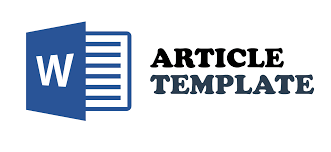This template is designed to assist Author in preparing manuscript; it is an exact representation of the format expected by the editor (downloadable at: Article Template). To use this template, please just Save As this MS Word file to your document, then copy and paste your document here. All papers submitted to the journal should be written in English language.
- The submitted manuscript has not been published before, and it is not being considered for publication elsewhere.
- Articles submitted to the journal are between 3,000-5,000 words written in English, using Microsoft Word, singe space, font Time New Roman, size 10pt, top and left margin 2.5 cm, bottom and right margin 2 cm, printed in A4 (210 x 297 mm) paper size.
- The title should be succinct and informative and no more than about 12 words in length. Do not use acronyms or abbreviations in your title and do not mention the method you used, unless your paper reports on the development of a new method. Titles are often used in information-retrieval systems. Avoid writing long formulas with subscripts in the title. Omit all waste words such as "A study of ...", "Investigations of ...", "Implementation of ...”, "Observations on ...", "Effect of.....", “Analysis of …”, “Design of…”, etc..
- The author’s name, e-mail address, and affiliation should be written below the title.
- Abstract should not more than 250 words containing the importance of the topic, objective, method, findings, and conclusion. It should not contain any undefined abbreviations and references.
- Below the abstract, about three to five keywords should appear along with the main body of the article.
- For research-based articles, the outlines used are: introduction, methods, findings and discussion, conclusion, and references.
- The introduction consists of the background of the study, research contexts, research objective, and literature review. All introductions should be presented in paragraphs form, not pointers, with 15-25% proportion of overall length of the article.
- The methods section consists of the description of the research design, setting, participants, data sources, data collection, and data analysis with 10-20% proportion of the total length of the article, all presented in paragraphs form.
- The findings and discussion section consist of description of the results of the data analysis to answer the research question(s) and their meanings seen from current theories and references from the intended area, with 40-60% proportion of the total length of the article.
- The conclusion section consists of the summary or evaluation of the main findings.
- Tables and figures are numbered sequentially with the table title and number above the table. The table should be in the center of the page. Tables must be followed by a space. Table titles must be in bold 10pt. Tables are referenced in the text by using table numbers (e.g.: Table 1.). In displaying the table, only use horizontal lines, vertical lines are not displayed.
- Quotation and references have to follow the latest APA style : Seventh Edition, and should be included at the end of the article.
- Every source cited in the body of the article should include in the references, and all sources listed in the references should be cited in the body of the article.
- At least 80% of the sources cited are from the last 10 years of publication. The sources cited are primary sources in the forms of journal articles, books, and research reports, including theses and dissertations. Maximum 15 references sources.
- If there is more than one appendix, they should be numbered consecutively. (paraphrase)
- The Journal operates a peer review process and ensures blind reviewing. In facilitating this process, the author’s names (without academic titles), institutional affiliation, and the corresponding author’s email address should appear only on a removable cover sheet.
- Proofs will be sent to the author for correction, and should be returned to journalofenglishteaching@unsimar.ac.id by the deadline given.




